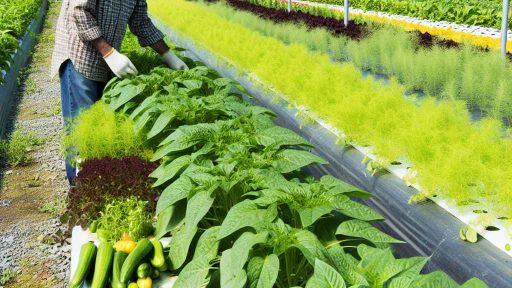Understanding Soil Health: Key Components and Indicators
Defining Soil Health
Soyl health refers to the ability of soil to sustain plant and animal life.
This definition encompasses chemical, physical, and biological properties.
Healthy soil maintains productivity while regulating water and nutrient cycles.
Key Components of Soil Health
Soil organic matter plays a crucial role in soil health.
This component enhances soil structure, fertility, and moisture retention.
Additionally, soil pH influences nutrient availability for plants.
Microbial activity indicates a thriving soil ecosystem.
Healthy soil hosts diverse microorganisms that promote plant growth.
Indicators of Soil Health
Monitoring soil health involves evaluating several key indicators.
Soil texture affects water retention and drainage capabilities.
Soil structure influences the movement of air and water.
Conducting a soil test can reveal nutrient levels and pH balance.
Another important indicator is the presence of organic matter content.
The Role of Soil Biology
Soil biology is fundamental to understanding soil health.
Beneficial bacteria and fungi contribute to nutrient cycling.
Transform Your Agribusiness
Unlock your farm's potential with expert advice tailored to your needs. Get actionable steps that drive real results.
Get StartedEarthworms and insects facilitate aeration and decomposition.
Healthy soil biology supports robust plant growth and resilience.
Impacts of Soil Health on Crop Diseases
Well-managed soil health reduces the prevalence of crop diseases.
Healthy soils promote strong root systems in plants.
These root systems help plants resist stress from pathogens.
Additionally, appropriate soil health practices can reduce disease pressure.
Benefits of Investing in Soil Health
Investing in soil health offers numerous advantages for farmers.
Healthy soils can lead to increased crop yields and profitability.
Furthermore, improved soil health enhances sustainability practices.
Farmers benefit from reduced needs for chemical inputs.
This, in turn, fosters a healthier environment for future generations.
The Role of Soil Microorganisms in Preventing Crop Diseases
Understanding Soil Microorganisms
Soi1 microorganisms play a crucial role in healthy farmland.
They include bacteria, fungi, and other microbes.
These tiny organisms interact with plants and soil nutrients.
Moreover, they contribute significantly to soil fertility.
Enhancing Soil Health
Healthy soil ecosystems promote beneficial microorganisms.
In turn, this balance helps suppress harmful pathogens.
For instance, certain bacteria can outcompete disease-causing organisms.
Additionally, healthy soils improve plant resilience to diseases.
This leads to healthier crops and better yields.
Interactions with Plant Roots
Soi1 microorganisms form symbiotic relationships with plant roots.
These relationships enhance nutrient absorption and growth.
Mycorrhizal fungi, for example, extend root systems beyond their natural reach.
As a result, plants access more water and essential nutrients.
Showcase Your Farming Business
Publish your professional farming services profile on our blog for a one-time fee of $200 and reach a dedicated audience of farmers and agribusiness owners.
Publish Your ProfileThese beneficial interactions strengthen plant health and prevent diseases.
Soil Microbes and Disease Resistance
Microorganisms produce natural compounds to combat pathogens.
These compounds can inhibit the growth of harmful fungi and bacteria.
For example, some bacteria synthesize antibiotics that protect crops.
Additionally, microbial diversity contributes to disease resistance.
When diverse microbes coexist, they create a healthier soil environment.
Strategies to Boost Soil Microbial Activity
Farmers can implement practices to promote soil health.
Crop rotation is an effective method for increasing microbial diversity.
Cover cropping also enriches soil and supports microorganisms.
Moreover, reducing chemical inputs helps maintain microbial populations.
Organic amendments like compost provide essential nutrients for these microbes.
Economic Benefits of Healthy Soils
Investing in soil health yields long-term economic advantages.
Crops grown in rich, healthy soils experience fewer diseases.
This results in reduced costs for pesticides and treatments.
Furthermore, healthier crops can lead to increased market value.
Ultimately, investing in soil microorganisms fosters sustainable farming practices.
Organic Matter: Enhancing Soil Structure and Nutrient Availability
The Role of Organic Matter
Organic matter is essential for healthy soil ecosystems.
It improves soil structure, which enhances aeration and water infiltration.
Additionally, it increases nutrient availability for crops.
As a result, farmers experience better crop yields and quality.
Types of Organic Matter
There are several types of organic matter that can benefit soil health.
- Compost is a rich source of nutrients and beneficial microorganisms.
- Green manure is grown specifically to be turned into the soil.
- Animal manure adds nutrients while improving soil texture.
Soil Structure Improvements
Enhanced soil structure leads to better root development.
Roots can access more water and nutrients effectively.
Furthermore, improved structure reduces erosion and compaction.
Nutrient Release Mechanisms
Organic matter aids in the slow release of nutrients.
Microorganisms break down organic matter, releasing essential nutrients.
This process ensures a steady supply of nutrients for plants.
Implementing Organic Matter in Farming Practices
Incorporating organic matter into soil requires planning and effort.
Farmers can achieve this through cover cropping and mulching.
Regularly applying compost enhances the nutrient profile of the soil.
Consistency is key for achieving long-term benefits.
Find Out More: Harvesting Methods for Organic Farming Landowners
Crop Rotation and Diversity: Strategies for Disease Management
Importance of Crop Rotation
Crop rotation plays a vital role in preventing crop diseases.
This practice involves alternating different crops in the same field.
Doing so disrupts the life cycles of pests and pathogens.
Consequently, it leads to healthier plants and increased yields.
Benefits of Diverse Planting
Diversity in planting enhances soil health and ecosystem resilience.
Planting various crops attracts beneficial insects and pollinators.
Additionally, diverse root systems improve soil structure and nutrient availability.
Therefore, incorporating multiple species can mitigate disease pressure.
Showcase Your Farming Business
Publish your professional farming services profile on our blog for a one-time fee of $200 and reach a dedicated audience of farmers and agribusiness owners.
Publish Your ProfileImplementing Crop Rotation Strategies
Farmers should develop a rotational plan tailored to their specific conditions.
A successful plan considers soil type, climate, and market demand.
For example, rotating legumes with cereals can enhance nitrogen fixation.
This technique provides essential nutrients for future crops.
Monitoring Crop Health
Regular monitoring is crucial for effective disease management.
Farmers should inspect their fields for early signs of illness.
Identifying affected plants promptly can prevent broader outbreaks.
Moreover, keeping detailed records aids in refining rotation strategies.
Adapting to Changing Conditions
Adapting practices ensures resilience against climate change and evolving pests.
Flexibility in crop choices allows farmers to respond to market shifts.
Moreover, integrating cover crops can enhance soil health during off-seasons.
This strategy contributes to sustainable farming practices in the long run.
Uncover the Details: Boosting Property Values Through Advanced Geographic Information System Tools
Utilizing Cover Crops to Improve Soil Fertility and Health
Introduction to Cover Crops
Cover crops play a vital role in modern agriculture.
They enhance soil structure and nutrient content.
Furthermore, they help in preventing erosion.
Types of Cover Crops
Diverse options are available for farmers to choose from.
- Legumes such as clover and vetch fix nitrogen in the soil.
- Cereal grains like rye and oats suppress weeds effectively.
- Brassicas, including radishes, enhance soil aeration.
Benefits of Implementing Cover Crops
Cover crops offer numerous benefits that improve soil health.
First, they increase organic matter, enhancing soil fertility.
Additionally, they improve water retention in dry conditions.
Moreover, they reduce the need for chemical fertilizers.
Improving Soil Microbial Activity
Utilizing cover crops boosts beneficial microbial populations.
These organisms play a crucial role in decomposing organic matter.
As a result, they release vital nutrients for subsequent crops.
Preventing Soil Erosion and Runoff
Cover crops reduce soil erosion significantly.
They stabilize soil with their root systems, preventing loss.
Consequently, this leads to less sediment and nutrient runoff.
Economic Impacts of Cover Crops
Investing in cover crops enhances farmland value over time.
It leads to reduced input costs by lowering fertilizer needs.
Additionally, farmers can experience increased crop yields.
Practical Steps for Implementing Cover Crops
Farmers should select appropriate cover crops based on climate.
Timing of planting is crucial for maximizing benefits.
Additionally, proper termination of cover crops is important.
This ensures that they contribute to soil health without competing.
Engaging the Farming Community
Spreading awareness is essential for implementing cover crops.
Farmers can share experiences through local workshops.
Furthermore, collaborative efforts can enhance knowledge and practices.
Long-Term Vision for Soil Health
Adopting cover crops leads to sustainable farming practices.
It ensures the farm’s health for future generations.
By investing in soil health, farmers increase resilience against diseases.
Showcase Your Farming Business
Publish your professional farming services profile on our blog for a one-time fee of $200 and reach a dedicated audience of farmers and agribusiness owners.
Publish Your ProfileDelve into the Subject: Greenhouse Planning for Large-Scale Farm Estates

Integrating Sustainable Practices
Reducing Chemical Input
Farmers increasingly recognize the importance of reducing chemical inputs.
Minimizing synthetic fertilizers fosters healthier soil ecosystems.
This process boosts microbial activity, enhancing nutrient availability.
Furthermore, organic fertilizers add vital organic matter to the soil.
Adopting integrated pest management offers an alternative to chemical pesticides.
This strategy combines biological control, habitat manipulation, and cultural techniques.
Consequently, farmers can manage pests effectively with minimal chemical reliance.
Alleviating Soil Stress
Soil stress contributes significantly to crop diseases.
To combat this, farmers should implement crop rotation practices.
Rotating different crops improves soil structure and fertility.
Cover cropping is another effective strategy against soil degradation.
These plants protect the soil from erosion while enhancing biodiversity.
Additionally, reduced tillage helps maintain soil moisture and integrity.
This technique limits soil disruption and fosters a thriving microbial community.
Implementing Sustainable Farming Techniques
Embracing agroecological practices promotes resilience in agricultural systems.
Intercropping benefits productivity while minimizing disease spread.
Incorporating perennials enhances soil stability and ecosystem health.
A diverse cropping system leads to enhanced pest suppression as well.
Consequently, agricultural diversity creates a buffer against crop failures.
Transformation towards sustainable practices requires commitment and planning.
However, the long-term benefits significantly outweigh initial challenges.
Discover More: Best Seed Varieties for High-Yield Farmland Development
Assessing Soil Health
Importance of Soil Health Assessment
Soil health is critical for sustainable agriculture.
Healthy soil increases crop resilience against diseases.
Furthermore, it enhances productivity and profitability.
Key Indicators of Soil Health
Several indicators help evaluate soil health effectively.
First, soil texture plays a crucial role.
Additionally, organic matter content is significant.
Other indicators include pH levels and microbial activity.
Tools for Soil Health Assessment
Farmers can utilize various tools to assess soil health.
Soil test kits offer essential measurements of nutrients.
Moreover, moisture meters help monitor water levels.
Sensors can provide real-time data on soil conditions.
Techniques for Soil Evaluation
Several techniques assist farmers in soil evaluation.
The visual soil assessment method involves direct observation.
Additionally, soil sampling helps obtain representative data.
Laboratory analysis provides detailed insights into soil composition.
Utilizing Technology for Soil Health Monitoring
Technology plays a vital role in soil health monitoring.
Drones allow for aerial soil assessments quickly.
Showcase Your Farming Business
Publish your professional farming services profile on our blog for a one-time fee of $200 and reach a dedicated audience of farmers and agribusiness owners.
Publish Your ProfileData analytics help interpret complex soil data effectively.
Apps can assist in tracking soil health over time.
Best Practices for Maintaining Soil Health
Practicing crop rotation enhances soil fertility.
Cover cropping protects the soil during off-seasons.
Additionally, reducing tillage preserves soil structure.
Implementing organic amendments can improve soil quality.
Economic Benefits of Soil Health: Investing in Long-term Crop Viability
Connection Between Soil Health and Crop Yields
Healthy soil directly impacts crop yields.
It enhances nutrient availability for plants.
Additionally, soil rich in organic matter improves moisture retention.
As a result, farmers see better harvests over time.
Reducing Crop Diseases through Soil Management
Strong soil ecosystems reduce the prevalence of crop diseases.
Microbial diversity in soil fights off harmful pathogens.
Moreover, healthy soil fosters robust root systems.
These roots help plants better withstand diseases and pests.
Cost Savings Through Soil Health Practices
Investing in soil health leads to significant cost savings.
Lesser dependency on chemical fertilizers reduces expenses.
Additionally, healthier crops require fewer pest control measures.
Over time, these savings accumulate into substantial profits.
Long-term Investment Returns
Investing in soil health is a long-term strategy.
Healthy soil improves profitability over successive growing seasons.
It also preserves farmland value, appealing to future investors.
Farmers who prioritize soil health often see better returns on investment.
Community and Economic Impact
Soil health investments positively impact local economies.
Increased agricultural productivity supports local jobs.
Moreover, healthy farmlands enhance community resilience.
This stability benefits all stakeholders in the agricultural sector.




